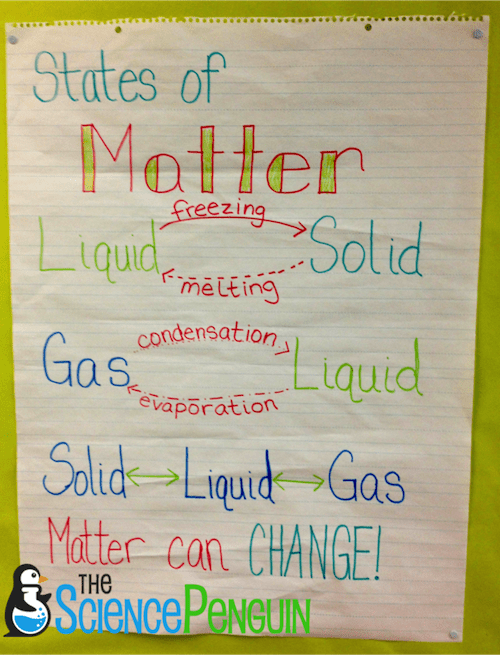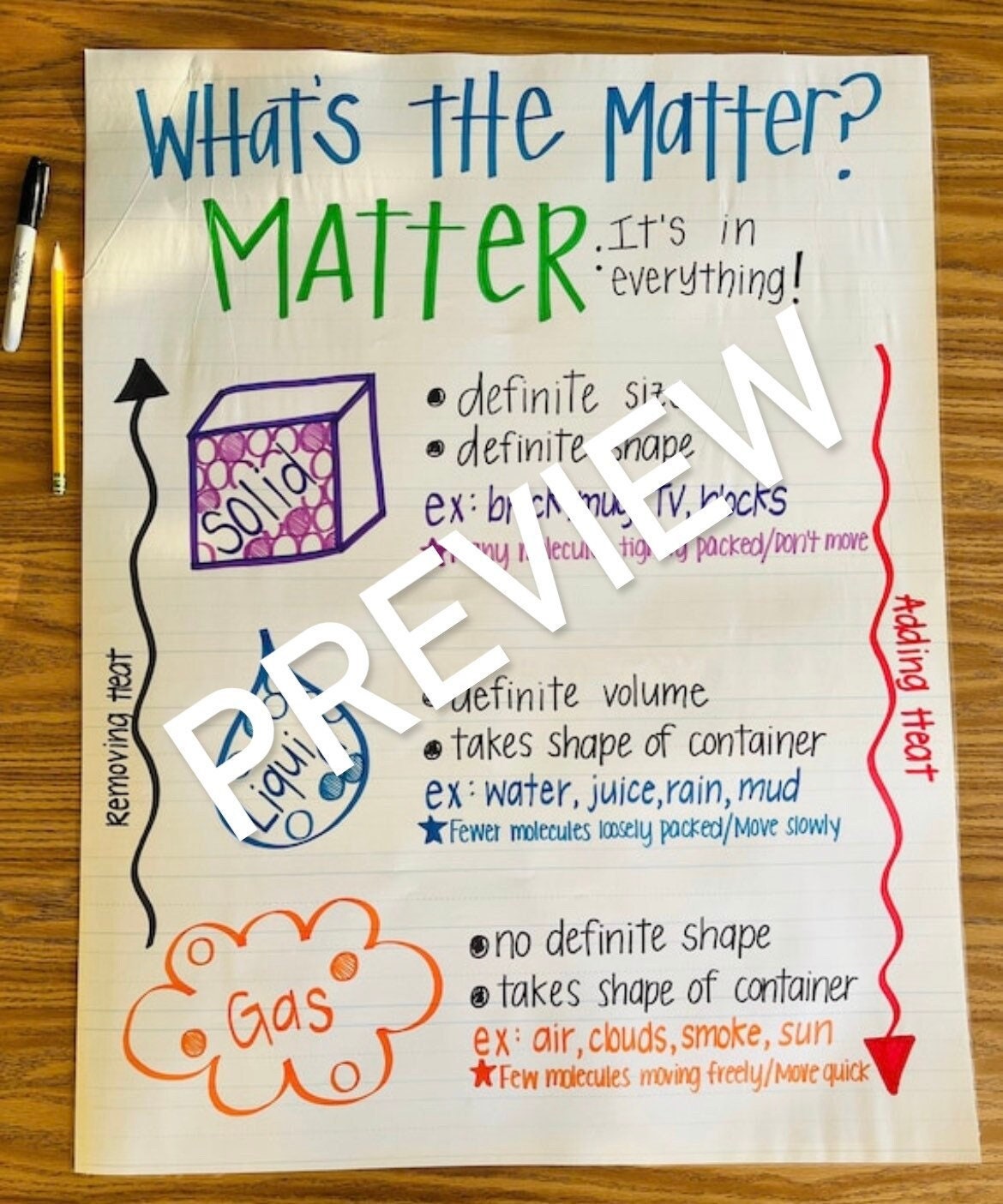
Solids, Liquids, & Gases! Rachel A Tall Drink of Water
TEKS 3.5 (B) describe and classify samples of matter as solids, liquids, and gases and demonstrate that solids have a definite shape and that liquids and gases take the shape of their container; NGSS 5-PS1-3.Make observations and measurements to identify materials based on their properties.

Sarah Price (priceless.ponderings) • Instagram photos and videos
States of Matter: Anchor Charts Anchor charts also make a fun activity to introduce science concepts to kids. Here is one I created for my class last year. I love using sticky notes to write down student responses. Throughout the week, I leave a pack of sticky notes out for them to write more examples of a solid, liquid, and gas.

States of matter = anchor charts, books, and food of course
Step 1: The Explicit States of Matter Lesson Introduce the Concept: Start with a simple explanation. Matter is everything around us and it comes in three forms - solids, liquids, and gases. Use everyday examples: ice (solid), water (liquid), and steam (gas). Visual Aids: Employ charts and images to visually represent the states of matter.

States of matter anchor chart Kindergarten Science, Elementary Science
States of Matter Solid Liquid Gas •Atoms are close together. •Has a definite size and shape. •Does not change. •Atoms are close, but can move. •Has definite volume. •Takes the shape of the container. •Atoms are far apart and move freely. •No definite shape or volume. •Takes the shape of and fills the container. Pixabay: Free for commercial use. No attribution re

States of matter anchor chart Education Pinterest Anchor charts
By Ronnie February 7, 2022 States of matter is a unit of study that will follow students for years to come! I've been teaching matter to my upper elementary students for a while now, and I have narrowed down go-to activities for teaching this unit. I love all matter activities and some of them are just so fun that I get so excited!

States of matter anchor chart. Science Skills, Science Ideas, Science
Today's anchor chart will define each state of matter . End this day with the Content Area Focus Wall Exit Slips and/or work on the project (if you plan to do the weekly projects). Wednesday. My favorite day of the week!! Lab day! This week is a simple science investigation for students to explore the states of matter. Students will tasks.

Solids, Liquids, & Gases! Rachel A Tall Drink of Water
Changing States of Matter Anchor Chart. Hi, I'm Ari! As a new teacher, I struggled to plan engaging, rigorous science lessons. Throughout my time teaching upper elementary and in my graduate studies, I discovered what worked well and developed science curriculum for busy teachers. Now, teachers across the country use Science Penguin activities.

Changing States of Matter Anchor Chart — The Science Penguin
1. Start with an anchor chart An anchor chart like this gives students something to reference as they learn the concepts and complete states of matter activities. Learn more: Terra Palmer/Pinterest 2. Read books about the states of matter Read a book or two to introduce younger learners to the concepts of solids, liquids, and gases.

States of Matter anchor chart Mrs. Griffin's Teaching Board
Summary. In this lesson, students will investigate particle behavior in different forms of matter: solid, liquid and gas. Students will examine a model of the particles in the different states of matter and will also participate in a kinesthetic demonstration of matter. They will also learn what makes the states of matter different from one.

Science Matter Anchor Chart Etsy
States of Matter Anchor Chart This anchor chart poster is a great tool to display in your science classroom or hand out to students to put in their notebooks or binder. Students will be be able to see particles in the form of solid, liquid, gas, and plasma. There is both the definition and a picture to help make the connection.

States of Matter Anchor Chart Matter anchor chart, Anchor charts
Are they looking on a way to supplement your physical properties and states of matter component? These lesson plans or activities are just what you need to help your students identify characteristics of solids, liquids, additionally natural. Use hands-on activities and anchor charted to teach students ways stylish whatever

States of Matter Anchor Chart! Matter Anchor Chart, Anchor Charts
6 Products $ 11.00 $ 18.00 Save $ 7.00 View Bundle Description Reviews Q&A More from Sarah Price - Priceless Ponderings Description Want to introduce your second grade and third grade students to properties of matter with fun science anchor charts and states of matter posters.

107 best Science anchor charts images on Pinterest Teaching science
Anchor Chart for Matter. I am all for anchor charts in my classroom. I have them all over and honestly I love them. When I launch this unit, I will have students take out 3 different colored sticky notes. Then they provide an example of each states of matter on each post it.

Properties of Matter anchor chart Physical Properties Of Matter
Are you looking for a way to supplement your physical properties and states of matter unit? These lesson plans and activities are just what you need to help your students identify characteristics of solids, liquids, and gases. Use hands-on activities and anchor charts to teach students ways in which matter can change from one property to another.

States of Matter Changes in Matter Anchor Chart Activity Sheet Etsy
Math Social Studies Anchor Charts One of my favorite science units to teach is Matter. It's challenging enough to not be too watered down, the students make a bunch of meaningful connections, and there are so many fun activities for the students to do to enhance their understanding of various topics.

Properties of matter anchor chart For School Pinterest Anchor
Amanda Richardson 5.0 (181) $6.25 PDF Explore states of matter with these engaging, fun-filled activities, graphic organizers, and 3 experiments to have your little learners engaged in their learning about solids, liquids, and gases!